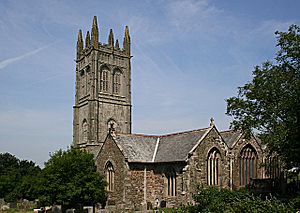St Probus and St Grace's Church, Probus facts for kids
Quick facts for kids St Probus and St Grace's Church, Probus |
|
|---|---|

St Probus and St Grace's Church, Probus
|
|
| Location | Probus, Cornwall |
| Country | England |
| Denomination | Church of England |
| Churchmanship | Broad church |
| History | |
| Dedication | St Probus and St Grace |
| Specifications | |
| Height | 126 feet (38 m) |
| Administration | |
| Parish | Probus |
| Deanery | Powder |
| Archdeaconry | Cornwall |
| Diocese | Truro |
| Province | Canterbury |
St Probus and St Grace's Church is a historic parish church located in the village of Probus, Cornwall, England. It belongs to the Church of England and is a Grade I listed building, meaning it's considered very important for its history and architecture.
Contents
A Look Back at St Probus Church History
This church has a long and interesting past. Before the Norman Conquest (which happened in 1066), there was a monastery here. This monastery continued to exist until the time of King Henry I, who ruled England from 1100 to 1135.
King Henry I later gave the church of Probus to Exeter Cathedral. After this, the church in Probus had a dean and five canons, who were important church leaders. The deanery was removed in 1268, and the canon positions ended in 1549. The first vicar, who is like the main priest for the local area, started his work here in 1312. The parish also had smaller chapels in nearby places like Cornelly and Merther.
Building the Church Tower
Most of the church was built in the 1400s. However, the tall tower was still being built in 1523. This tower is the tallest among all the parish churches in Cornwall. It looks more like the towers found in Somerset, another English county, than other towers in Cornwall.
The stone for the tower was brought by local people, called parishioners, using their carts. A man named John Tregian of Golden led this effort. However, there was a rivalry with another important local person, Nicholas Carminow of Trenowth, who was John's brother-in-law. Nicholas tried hard to stop the building work.
Restoring the Church
The church was repaired and improved in 1850 by a famous architect named George Edmund Street. This restoration was needed because of a problem called dry rot, which damages wood. Before the repairs, the ceilings were covered with plaster, and the stone pillars were painted white. The church also had very tall wooden pews. The arch leading into the tower was blocked by a gallery, which also covered the main window at the west end of the church. All these issues were fixed, and the church reopened on October 28, 1851.
Later, the tower itself was restored between 1922 and 1923 by a company called J. Dawson and Sons, who were experts in working on tall structures.
In the early 1800s, people at Probus church followed a special custom. When they finished saying each Psalm, especially those in the choir, they would turn to the East for the Doxology.
Parish Connections
St Probus and St Grace's Church is part of a group of churches called a benefice. This means it shares a vicar and resources with several other churches in the area. These include:
- St Crida's Church, Creed
- St Nun's Church, Grampound
- St Ladoca's Church, Ladock
- St Hermes' Church, St Erme
The Church Organ
The organ inside the church was built in 1884 by a company called Hele & Co. You can find detailed information about this organ on the National Pipe Organ Register.

